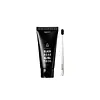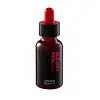What's inside
What's inside
 Key Ingredients
Key Ingredients

 Benefits
Benefits

 Concerns
Concerns

 Ingredients Side-by-side
Ingredients Side-by-side

Water
Skin ConditioningGlycerin
HumectantDisodium Cocoamphodiacetate
CleansingCoco-Betaine
CleansingMethyl Perfluoroisobutyl Ether
SolventAcrylates Copolymer
Methyl Perfluorobutyl Ether
SolventSodium Chloride
MaskingDecyl Glucoside
CleansingPotassium Cocoyl Glycinate
Potassium Cocoate
EmulsifyingSodium Hyaluronate
HumectantGlucomannan
Skin ConditioningCharcoal Powder
AbrasiveButylene Glycol
HumectantCamellia Sinensis Leaf Extract
AntimicrobialAnanas Sativus Fruit Extract
Skin ConditioningAloe Barbadensis Leaf Extract
EmollientSalix Alba Bark Extract
AstringentOriganum Vulgare Leaf Extract
Skin ConditioningChamaecyparis Obtusa Leaf Extract
Skin ConditioningPyrus Malus Fruit Extract
Skin ConditioningPortulaca Oleracea Extract
Skin ConditioningScutellaria Baicalensis Root Extract
AstringentLactobacillus/Soybean Ferment Extract
Skin ConditioningCinnamomum Cassia Bark Extract
MaskingVaccinium Angustifolium Fruit Extract
Skin ProtectingAllium Sativum Bulb Extract
Skin ConditioningRubus Fruticosus Fruit Extract
AstringentGlycine Soja Seed Extract
Skin ConditioningJuniperus Communis Fruit Extract
PerfumingMorus Alba Fruit Extract
AntioxidantOryza Sativa Extract
AbsorbentSesamum Indicum Seed Extract
Skin ConditioningMelaleuca Alternifolia Leaf Extract
PerfumingCitrus Aurantium Bergamia Fruit Oil
MaskingCitrus Nobilis Peel Oil
MaskingCitrus Aurantium Dulcis Peel Oil
MaskingLavandula Angustifolia Oil
MaskingLecithin
EmollientDisodium EDTA
Arginine
MaskingHexylene Glycol
EmulsifyingChlorphenesin
Antimicrobial1,2-Hexanediol
Skin ConditioningEthylhexylglycerin
Skin ConditioningLimonene
PerfumingWater, Glycerin, Disodium Cocoamphodiacetate, Coco-Betaine, Methyl Perfluoroisobutyl Ether, Acrylates Copolymer, Methyl Perfluorobutyl Ether, Sodium Chloride, Decyl Glucoside, Potassium Cocoyl Glycinate, Potassium Cocoate, Sodium Hyaluronate, Glucomannan, Charcoal Powder, Butylene Glycol, Camellia Sinensis Leaf Extract, Ananas Sativus Fruit Extract, Aloe Barbadensis Leaf Extract, Salix Alba Bark Extract, Origanum Vulgare Leaf Extract, Chamaecyparis Obtusa Leaf Extract, Pyrus Malus Fruit Extract, Portulaca Oleracea Extract, Scutellaria Baicalensis Root Extract, Lactobacillus/Soybean Ferment Extract, Cinnamomum Cassia Bark Extract, Vaccinium Angustifolium Fruit Extract, Allium Sativum Bulb Extract, Rubus Fruticosus Fruit Extract, Glycine Soja Seed Extract, Juniperus Communis Fruit Extract, Morus Alba Fruit Extract, Oryza Sativa Extract, Sesamum Indicum Seed Extract, Melaleuca Alternifolia Leaf Extract, Citrus Aurantium Bergamia Fruit Oil, Citrus Nobilis Peel Oil, Citrus Aurantium Dulcis Peel Oil, Lavandula Angustifolia Oil, Lecithin, Disodium EDTA, Arginine, Hexylene Glycol, Chlorphenesin, 1,2-Hexanediol, Ethylhexylglycerin, Limonene
Water
Skin ConditioningGlycolic Acid 8%
BufferingButylene Glycol
HumectantGlycerin
Humectant1,2-Hexanediol
Skin ConditioningNiacinamide
SmoothingPotassium Hydroxide
BufferingXanthan Gum
EmulsifyingGardenia Florida Fruit Extract
Skin ConditioningDextrin
AbsorbentSalicylic Acid
MaskingGluconolactone
Skin ConditioningTheobroma Cacao Extract
Skin ConditioningPropanediol
SolventEthylhexylglycerin
Skin ConditioningDisodium EDTA
Sodium Hyaluronate
HumectantCapryloyl Salicylic Acid
ExfoliatingAloe Barbadensis Leaf Extract
EmollientMalus Domestica Fruit Extract
AntioxidantBeta Vulgaris Root Extract
Skin ConditioningVaccinium Macrocarpon Fruit Extract
AstringentSolanum Lycopersicum Fruit Extract
AntioxidantRubus Idaeus Fruit Extract
AstringentPunica Granatum Fruit Extract
AntioxidantMalpighia Emarginata Fruit Extract
Skin ConditioningCapsicum Annuum Fruit Extract
AntimicrobialDaucus Carota Sativa Root Extract
Skin ConditioningHippophae Rhamnoides Fruit Juice
Skin ConditioningMaltodextrin
AbsorbentHydrolyzed Pea Protein
EmollientPhytosterols
Skin ConditioningSqualane
EmollientOlea Europaea Fruit Oil
MaskingLecithin
EmollientCeramide NP
Skin ConditioningCaprylyl Glycol
EmollientButyrospermum Parkii Butter
Skin ConditioningWater, Glycolic Acid 8%, Butylene Glycol, Glycerin, 1,2-Hexanediol, Niacinamide, Potassium Hydroxide, Xanthan Gum, Gardenia Florida Fruit Extract, Dextrin, Salicylic Acid, Gluconolactone, Theobroma Cacao Extract, Propanediol, Ethylhexylglycerin, Disodium EDTA, Sodium Hyaluronate, Capryloyl Salicylic Acid, Aloe Barbadensis Leaf Extract, Malus Domestica Fruit Extract, Beta Vulgaris Root Extract, Vaccinium Macrocarpon Fruit Extract, Solanum Lycopersicum Fruit Extract, Rubus Idaeus Fruit Extract, Punica Granatum Fruit Extract, Malpighia Emarginata Fruit Extract, Capsicum Annuum Fruit Extract, Daucus Carota Sativa Root Extract, Hippophae Rhamnoides Fruit Juice, Maltodextrin, Hydrolyzed Pea Protein, Phytosterols, Squalane, Olea Europaea Fruit Oil, Lecithin, Ceramide NP, Caprylyl Glycol, Butyrospermum Parkii Butter
Ingredients Explained
These ingredients are found in both products.
Ingredients higher up in an ingredient list are typically present in a larger amount.
1,2-Hexanediol is a synthetic liquid and another multi-functional powerhouse.
It is a:
- Humectant, drawing moisture into the skin
- Emollient, helping to soften skin
- Solvent, dispersing and stabilizing formulas
- Preservative booster, enhancing the antimicrobial activity of other preservatives
Aloe Barbadensis Leaf Extract is an extract of the leaves of the aloe, Aloe barbadensis, Liliaceae.
Aloe is one of the most well-known natural soothing ingredients, and for good reason. It’s full of water and has a cooling, calming effect on the skin, especially when it’s sunburned, itchy, or irritated. Aloe also helps your skin stay hydrated and smooth by mimicking what healthy skin naturally produces. On top of that, it contains vitamins and nutrients that support skin recovery.
It doesn’t protect you from the sun, but it can help your skin bounce back after too much time in it.
Let’s get into the details:
Aloe contains antioxidant Vitamins A, C, and E, which help fight off free radicals (unstable molecules from things like pollution that can damage your skin).
It’s also rich in polysaccharides, which are natural sugars that help hydrate the skin by acting like the skin’s own moisturizing agents. These, along with other sugars like monosaccharides, help form a protective barrier that locks in moisture.
Aloe works as both a humectant and an emollient. That means it draws water into the skin (humectant) and helps trap it there (emollient), making it an effective natural moisturizer.
You’ll also find a mix of other skin-supporting ingredients in aloe, including folic acid, choline, calcium, amino acids, fatty acids, and even Vitamin B12.
Out of the 420+ species of aloe, Aloe barbadensis is the most widely used in skincare products thanks to its gentle yet effective properties.
There are over 420 species of aloe but Aloe Barbadensis is the most commonly used for topical products.
Learn more about Aloe Barbadensis Leaf ExtractButylene Glycol (or BG) is used within cosmetic products for a few different reasons:
Overall, Butylene Glycol is a safe and well-rounded ingredient that works well with other ingredients.
Though this ingredient works well with most skin types, some people with sensitive skin may experience a reaction such as allergic rashes, closed comedones, or itchiness.
Learn more about Butylene GlycolDisodium EDTA plays a role in making products more stable by aiding other preservatives.
It is a chelating agent, meaning it neutralizes metal ions that may be found in a product.
Disodium EDTA is a salt of edetic acid and is found to be safe in cosmetic ingredients.
Learn more about Disodium EDTAEthylhexylglycerin (we can't pronounce this either) is commonly used as a preservative and skin softener. It is derived from glyceryl.
You might see Ethylhexylglycerin often paired with other preservatives such as phenoxyethanol. Ethylhexylglycerin has been found to increase the effectiveness of these other preservatives.
Glycerin is already naturally found in your skin. It helps moisturize and protect your skin.
A study from 2016 found glycerin to be more effective as a humectant than AHAs and hyaluronic acid.
As a humectant, it helps the skin stay hydrated by pulling moisture to your skin. The low molecular weight of glycerin allows it to pull moisture into the deeper layers of your skin.
Hydrated skin improves your skin barrier; Your skin barrier helps protect against irritants and bacteria.
Glycerin has also been found to have antimicrobial and antiviral properties. Due to these properties, glycerin is often used in wound and burn treatments.
In cosmetics, glycerin is usually derived from plants such as soybean or palm. However, it can also be sourced from animals, such as tallow or animal fat.
This ingredient is organic, colorless, odorless, and non-toxic.
Glycerin is the name for this ingredient in American English. British English uses Glycerol/Glycerine.
Learn more about GlycerinLecithin is a term for a group of substances found in the cell membranes of plants, animals, and humans. They are made up of mixture of phospholipids.
This ingredient has emollient and emulsifying properties.
As an emollient, lecithen helps soften the skin and creates a barrier to keep moisture in.
As an emulsifier, it also helps prevent water and oil ingredients from separating. Lecithin can also help ingredients be better absorbed by the skin.
This is because the phospholipids in lecithin produce liposomes. Liposomes help other ingredients get through the skin barrier.
Depending on the source of this ingredient, lecithin may not be fungal acne safe. This is because some sources of lecithin come from soybean oil, which may feed the malassezia yeast that feeds fungal acne.
We recommend reaching out to the brand you are purchasing from to inquire about the source of their lecithin.
Some other names for this ingredient include soy lecithin and deoiled soy lecithin.
Learn more about LecithinSodium Hyaluronate is hyaluronic acid's salt form. It is commonly derived from the sodium salt of hyaluronic acid.
Like hyaluronic acid, it is great at holding water and acts as a humectant. This makes it a great skin hydrating ingredient.
Sodium Hyaluronate is naturally occurring in our bodies and is mostly found in eye fluid and joints.
These are some other common types of Hyaluronic Acid:
Learn more about Sodium HyaluronateWater. It's the most common cosmetic ingredient of all. You'll usually see it at the top of ingredient lists, meaning that it makes up the largest part of the product.
So why is it so popular? Water most often acts as a solvent - this means that it helps dissolve other ingredients into the formulation.
You'll also recognize water as that liquid we all need to stay alive. If you see this, drink a glass of water. Stay hydrated!
Learn more about Water